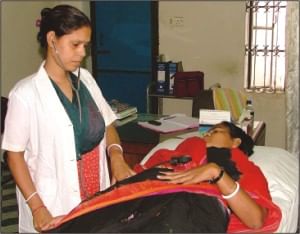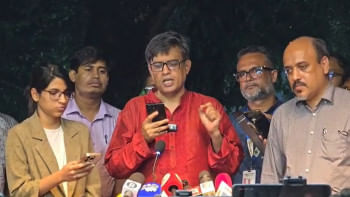<i>BGMEA healthcare centres need expansion</i>

A doctor examines a female garment worker at a BGMEA-run healthcare centre in the port city.Photo: STAR
Seventeen-year-old Archana, a garment worker, has been suffering from severe fever for the last two months and has not gone to doctor because she does not have enough money for treatment.
As her condition deteriorated, she visited a doctor who found her affected by typhoid and prescribed some expensive medicines that she can't afford.
Then Archana, according to the advice of her colleagues, goes to the healthcare centre of Bangladesh Garment Manufacturers and Exporters' Association (BGMEA) at Muradpur in the port city and got cured after treatment free of cost.
Like Archana, thousands of garment workers in Chittagong usually neglect their illness for fear of high treatment cost.
The ailing workers generally tend to go to a nearby pharmacy and take a few medicines for treatment without doctors' advice due to financial constraints and expensive treatment, said Belal, a garment worker.
With a view to providing healthcare facilities free of cost to the workers, BGMEA set up two healthcare centres in the port city in 2000 -- one at Sheikh Mujib Road and another in Bayezid Bostami area that was later shifted to Muradpur.
The centres also provide healthcare facilities to the family members of garment workers.
A total of 33,983 patients, mostly garment workers, received healthcare services from Agrabad Health Centre-1 from October 2000 to September 2007, sources at the centre said.
It provides treatment and medicine and also lab facilities to diagnose certain diseases free of cost.
BGMEA signed a project document with the government and United Nations Population Fund (UNFPA) on October 28 in 1998 to provide family welfare and reproductive health education and services to the garment workers.
Under a three-year project UNFPA started supporting the Health Care Centre-2 at Muradpur in 2003 to cover 75 factories in the port city.
UNFPA also took a six-year project titled 'Promotion of Reproductive Health, Gender Equity and Women's Empowerment' in the centre in 2005 to cover 100 factories.
Medical officer Dr Muslina Akhter Nargis said the number of patients is increasing day by day.She said they have an ambulance to ensure emergency service for the workers.
Around 2,905 patients were treated in the centre in 2003 while 5,426 in 2006, sources said.
A total of 30,549 garment workers and members of their families received services as of September this year.
Besides, the Muradpur Health Centre arranges awareness programmes on family welfare, reproductive health, sexually transmitted diseases (STD) like HIV and AIDS, early marriage and women's empowerment, said project officer Nazneen Begum.
As part of the awareness and motivational programme the centre organises a daylong workshop every month on these issues, where at least two workers from each factory participate.
Nazneen said they visit factories regularly and talk to workers as well as the production manager, compliance manager or welfare officer and try to pursue them to allow the sick and injured workers to visit the health centre.
But majority of the workers are still deprived of medical facilities as two centres are not enough to serve around five lakh working in 684 factories here.
Many workers don't go to the centres as they live far from their workplaces, said Rokeya, a worker of Deluxe Fashion of Klifton Group.
Delwar Hossain, working in P&G Textile, urged the BGMEA to set up such centres in the industrial zones so that more workers can avail the facilities.
AKM Moyeen Uddin, senior assistant secretary of BGMEA, said they have plans to expand the project with a view to covering more workers.

 For all latest news, follow The Daily Star's Google News channel.
For all latest news, follow The Daily Star's Google News channel. 



Comments